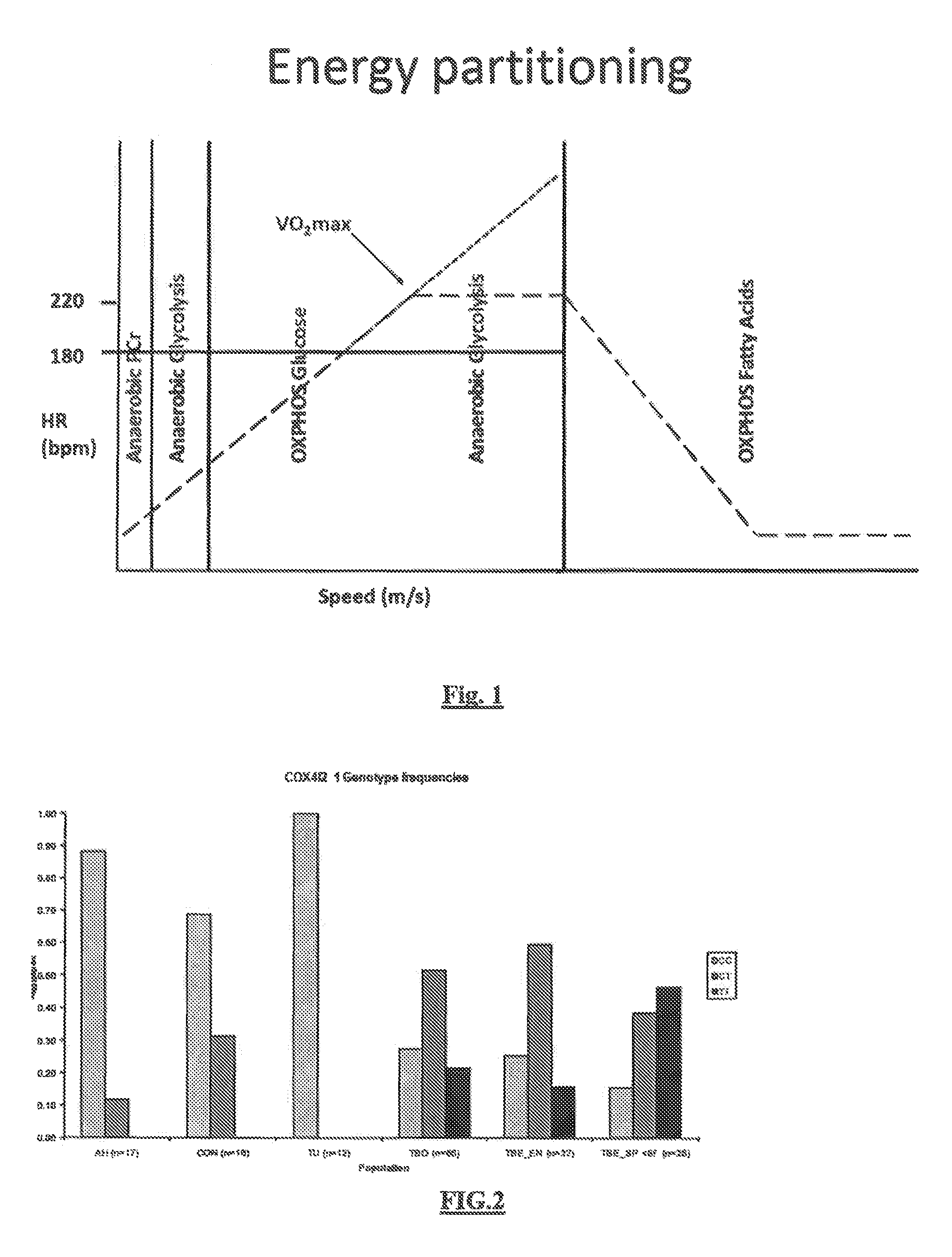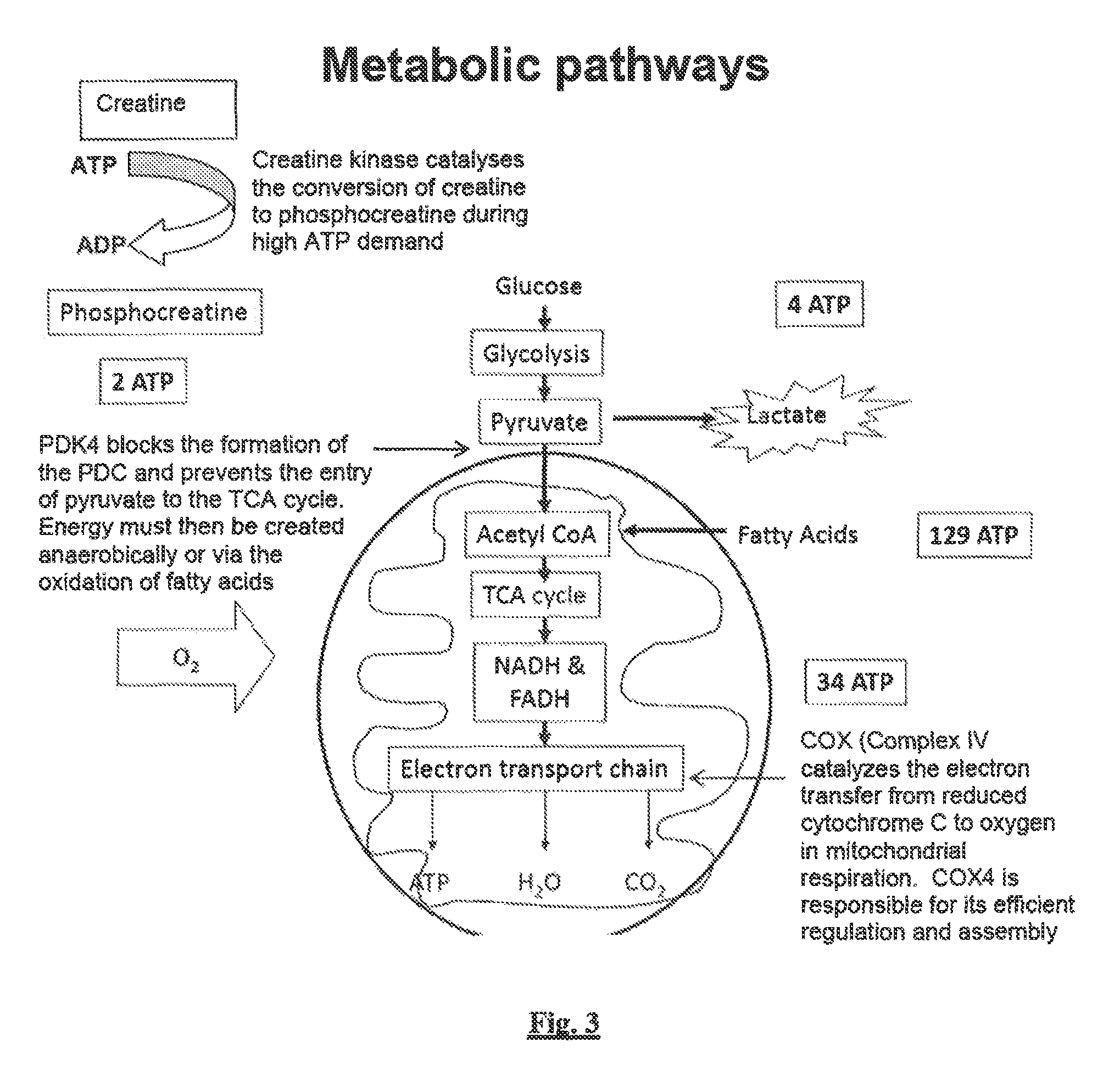Method for predicting athletic performance potential
a technology of athletic performance and potential, applied in the field of athletic performance potential prediction, can solve the problem of greatly limited energy requirements
- Summary
- Abstract
- Description
- Claims
- Application Information
AI Technical Summary
Benefits of technology
Problems solved by technology
Method used
Image
Examples
example 1
COX4I2
[0085]During sprint exercise, energy in the form of ATP, necessary for muscle contraction, is generated principally by aerobic metabolic pathways (70% aerobic, 30% anaerobic) albeit in a limited oxygen environment. We suggest that this relative hypoxic environment triggers the well-conserved metabolic switch from COX4-1 to COX4-2 thereby increasing the efficiency of cellular respiration. COX4-2 is therefore an important regulator of energy supply during sprinting, but not necessarily in longer distance competitions where oxygen demands are met. This switch is mediated by the transcription factor HIF-1α in the cell that has been well-characterised as the master regulator of hypoxia-dependent gene expression (Semenza 1998). HIF-1α activates the transcription of genes encoding PDK1, LDHA, COX4-2 and LON and controls the switch from COX4-1 to COX4-2. In Thoroughbred muscle that is deprived of oxygen during intense exercise an enhanced response to reduced oxygen and the ability to ...
example 2
Genes Associated with Thoroughbred Racing Performance
[0102]We investigated associations between 80 SNPs in the following genes: ACN9, ACSS1, ACTA1, ACTN2, ADHFE1, GGPS1, GSN, MC3R, MTFR1, NDUFA8, PDK4, PON1, PTGS1, PTPN1, TNC, TOMM20, UGCG CKM, COX4I2, COX4I1, HIF1A, MYEF2, and PRKAA1 (details of the SNPs are given in the appendices with racing performance in Thoroughbreds).
[0103]The present invention identifies significant associations between SNPs and athletic performance phenotypes in a set of these genes including ACN9, ACSSJ, ACTN2, ADHFE1, CKM, COX4I2, GSN, MSTN, PON1, PTGS1 and PTPN1 (see the appendices). Because of the known gene expression response to exercise in equine skeletal muscle (Eivers et al 2009) and evidence for association with performance in dogs (Mosher et at 2008) and response to training, four of the genes (CKM, COX4I2, PDK4 and MSTN) that had a significant association with Thoroughbred racing performance were investigated in detail. SNPs in three of those ge...
example 3
A Multi-Gene Prediction Test for Elite (Group Race Winning) Performance in Thoroughbred Horses
[0145]The present invention provides a simple DNA based method (genotypic test) for predicting the athletic performance of a thoroughbred race horse based on the presence or absence of a SNP in one or more exercise response gene. The exercise response gene may be one or more of the genes listed in the appendices. For example the genotypic test may be based on a SNP in one or more of the PDK4, CKM, COX4I2, COX4I1, MSTN, ACSS1, ACTN2 or PTGS1 genes. Details of some of the SNPs that may be used to predict the athletic performance of a thoroughbred horse are given in the appendices. It will be appreciated that the genotypic test may be based on a combination of any one or more of these SNPs.
[0146]Referring to FIG. 3, the three main metabolic pathways contributing to energy production during exercise and the location in the pathways and the function of three genes (CKM, COX4I2 and PDK4) associat...
PUM
| Property | Measurement | Unit |
|---|---|---|
| distance | aaaaa | aaaaa |
| distances | aaaaa | aaaaa |
| distances | aaaaa | aaaaa |
Abstract
Description
Claims
Application Information
 Login to View More
Login to View More - R&D
- Intellectual Property
- Life Sciences
- Materials
- Tech Scout
- Unparalleled Data Quality
- Higher Quality Content
- 60% Fewer Hallucinations
Browse by: Latest US Patents, China's latest patents, Technical Efficacy Thesaurus, Application Domain, Technology Topic, Popular Technical Reports.
© 2025 PatSnap. All rights reserved.Legal|Privacy policy|Modern Slavery Act Transparency Statement|Sitemap|About US| Contact US: help@patsnap.com



